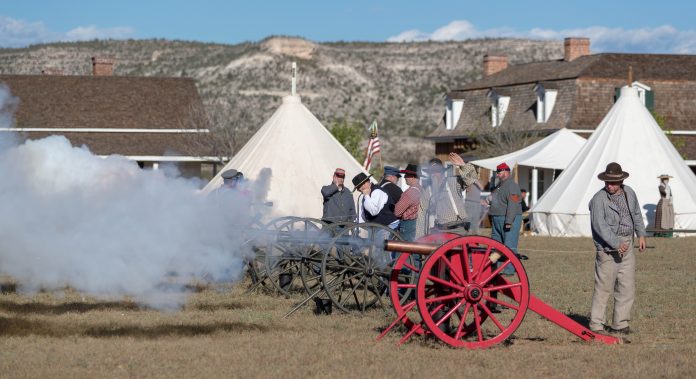The historic buildings of Fort Verde State Historic Park, dating back to the late 19th century and the Indian Wars when the fort was operated by the U.S. military, held host this past weekend to a regiment of uniformed fighters. For the annual “History of the Soldier” event, historical re-enactors covered the heritage site, bearing uniforms not only of the Indian Wars that led to the fort, but also regalia of the American wars before and after, from the Revolution all the way through the 20th century.
“It’s warm but it’s better than when it’s 115 degrees in the summer,” said Camp Verde resident Ed Lee, who had come in a 2nd lieutenant’s uniform based on the one worn by Henry O. Flipper, who became the first black officer to graduate West Point in 1877.
Other re-enactors came in even stuffier dress. One introduced himself as Sir John Redmayne, a major in his majesty’s royal guards, with blue color along with his trademark red coat, epaulets and a gorget, a silver badge embossed with the king’s rank, hanging from his neck. Another naval officer showed off the sharp cutlass hanging from his waist, which remained a part of military uniforms alongside modern weaponry all the way until World War II, and highlighted the one final weapon on his person — a neckerchief, which could in a pinch be unfurled to be used as a whip.
“Instead of reading about it in a book or online, they come to see it come to life,” said Matt Pocklington, a Prescott resident who came to the fort dressed as a soldier from the U.S. 5th Cavalry, along with a group of traveling re-enactors called the Legends of the American West. “Instead of virtual reality, it’s reality.”
Pocklington and his compatriots highlighted Arizona as a great state for historical re-enactment, even as opportunities for events have dried up all over the country. They highlighted as well the fort’s well- preserved heritage, giving enthusiasts a perfect setting to show off history.
“There’s so much history that’s here on site they work so hard to make come alive,” Donna Leatherman, a Legends of the American West participant who came all the way from Reno, said.
In addition to the costumes, the event boasted enormous cannons that fired off just the way they did in the days of great battles. And unique this year was the large exhibit on the USS Monitor, the Union ironclad that changed naval warfare forever when it fought the CSS Virginia [previously the USS Merrimack] in The Battle of Hampton Roads in March of 1862.
“The world went from wooden ships to iron ships in about four hours,” Dave Williamson, the costumed recreations who designed the Monitor exhibit, said. He explained to onlookers about how, with its fully rotatable turrets and iron hull, the Monitor represented a jump forward in the possibilities of warfare so great that the U.S. Navy refused to fully pay for its construction until it was tested in battle. “Everybody’s technology gets pulled forward by leaps and bounds. It was all-new tech. None of it had been tested.”
John Yazzie explains his outfit to the audience at a military “fashion show” at the annual History of the Soldier event on Saturday, April 13, at Fort Verde State History Park in Camp Verde. Yazzie is dressed as a U.S. Marine Corps grenadier from World War II.
While the fort was not able to boast a full-size model of the Monitor, it did feature an outline displaying the full size of the ship on the ground, as well as a model of one of its rotating turrets, with which an 8-person crew was able to fire a 167- pound cannonball over 2 miles every seven minutes.
“You can read it in books but when you come see it and think, ‘Look how big these turrets are!’ it really sticks in your head,” Williamson said after showing the Deily family visiting from Seattle the turret model.
“It’s part of their heritage,” said Lisa Deily, relishing the chance to show history to her children Jack and Bryn. “Their great grandfather was a Marine Corps colonel.”
“The interest is quite strong,” Eric Daily said. “I’ve always had a fascination with military history. They really brought it to life.”



